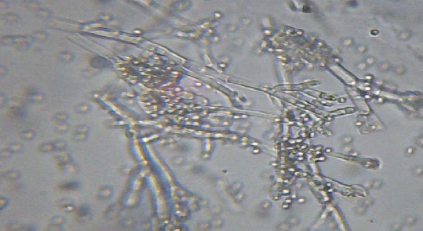- How to choose an ozone generator
- About ozone
- coronavirus
- Water ozonation
- Ozonation of fruit and vegetables
- Contact
- Vehicle ozonation
- Ozone concentration
- Ways of ozonation
- The use of ozone in industry
- Air Ozonizers
- Ozonation of cereals
- Ozone treatment in the meat industry
- Ozonation in cold rooms
- Fire - ozonation
- Ozone breakdown in water
- Allergy
- Ozone compatible materials
- Decontamination of air conditioning with ozone
- Ozone water treatment
- Home ozone generator
- Mushrooms
- Sewage ozonation
- Ozonation of hotel rooms
Mold mushrooms - they harm people
They live in flats, laboratories, hospitals, archives, libraries, sewage treatment plants, landfills, cowsheds, piggeries, and poultry houses, i.e. wherever people and animals reside. I am talking about bacteria and mold fungi. The latter appear especially in buildings that are constantly damp or flooded during the floods.
Penicillium
 Fungi of the genus Penicillium have strong allergenic properties, being a frequent cause of allergic respiratory diseases, which include: bronchial asthma, allergic rhinitis, allergic alveolitis allergic alveolitis, pulmonary asthma.
Fungi of the genus Penicillium have strong allergenic properties, being a frequent cause of allergic respiratory diseases, which include: bronchial asthma, allergic rhinitis, allergic alveolitis allergic alveolitis, pulmonary asthma.
Fungi of the genus Penicillium also show toxic effects due to their ability to produce harmful metabolism products called mycotoxins. Mycotoxins are ring-shaped compounds that are toxic to both humans and animals. Mycotoxins also have teratogenic, carcinogenic and mutogenic effects ... Fungi of the genus Penicillium can produce a number of mycotoxins (secondary metabolites), the most common of which are: citrine, citreviridine, ochratoxin, cyclopiazonic acid, patulin and rubratoxin. Ochratoxin A is the cause of a urinary tract disease called nephropathy.
We don't know what we're breathing
Sniffing the air, we do not wonder what is in it. And we breathe not only a mixture of oxygen and nitrogen, but also a complex combination of bacteria, viruses and mold fungi. The composition of the air depends on many environmental factors, including terrain location, climate, vegetation, amount and type of precipitation, population density, soil, type of industrial plants operating in the area.
We breathe, among others bioaerosols - two- or three-phase systems consisting of a dispersing phase (air) and a dispersed phase (solid or liquid) containing microbes. The dispersed phase is small particles of a fluid or solid to which plant pollen, fungal spores, bacterial cells, viruses, etc. are attached.
Mainly saprophytic microorganisms, resistant to drying, are suspended in the city air. Molds predominate in our air (approx. 80% of the air composition, and the share of bacteria ranges from 19-26%). The most common molds found in the air are: Penicillium, Aspergillus, Rhizopus, Mucor, Cladosporium, Alternaria. .
Dangerous and difficult to destroy
Fungi spores can survive in the air for many years thanks to the thick cell wall and protective dyes. They are difficult to fight and especially dangerous in gatherings of people, e.g. hospitals, sanatoriums, schools, workplaces or flats. Spreading by air, they can cause occupational diseases, allergies, bronchial asthma, infectious diseases, food spoilage, technical materials (plasters, building partitions) and others.
Penicillium, Aspergillus, Rhizopus, Mucor, Cladosporium, Alternaria dominate in the atmospheric air, while "home" molds are primarily Penicillium, Aspergillus, Rhizopus, Mucor . This division is arbitrary because Cladosporium and Alternaria (responsible for allergies) also occur in the rooms in which we stay.
It is estimated that 30 percent health problems are associated with the quality of air we breathe indoors (this is related to the presence of mold). Mold in the air and on building materials can occur in two forms: spores and hyphae mycelium. In both cases, they are carriers of metabolites harmful to humans (mycotoxins and volatile compounds). Molds penetrate the human body through the respiratory, digestive and skin systems. Exposure to disease depends on the individual immunity of the human body.
What threaten us?
The higher the concentration of spores and hyphae in the air and the longer the exposure time to polluted air, the greater the likelihood of diseases. Most often we deal with fungal infections (skin, nails, hair and internal organs, e.g. lungs), allergies (watery eyes, chronic runny nose, conjunctivitis), mycotoxinosis, respiratory tract inflammation up to and including bronchial asthma.
People who live in mushroomed rooms for a long time can be sick with sick home syndrome or chronic fatigue syndrome. The basic symptoms of sick home syndrome include fatigue, nausea, dizziness, irritability, reduced concentration, attention, memory impairment, irritation of the mucous membranes of the eyes, nose, throat, skin redness and asthmatic symptoms (dyspnoea and coughing attacks). Chronic fatigue syndrome in most cases develops as a paraguay state that does not subside after treatment. Symptoms are: increase in body temperature, dry rhinitis, throat, muscle weakness, joint pain, sleep disturbance, memory impairment, depression. These syndromes can occur if the symptoms persist for more than 6 months. In both cases, the symptoms disappear after moving out of the molded flats.
Organ fungal infections are most often caused by Aspergillus fumigatus. This type of fungus causes pneumonia, bronchitis, pleurisy, bronchopulmonary aspergillosis and disseminated brain and kidney aspergillosis. In extreme cases it leads to death.
Many fungi produce allergens and mycotoxins that have multidirectional toxic effects, e.g., damage and cause cirrhosis, haemorrhage (lung, brain, liver), gastrointestinal disturbance, kidney damage, nerve palsy, weight loss, genital and fetal damage (formic), they are carcinogenic. They also cause farm animals to die.
One of the most dangerous fungi is Stachybotrys atra , which causes frequent infections, dermatitis, headache, malaise, vomiting, diarrhea, and internal fatal bleeding. This species of fungus occurs after flooding apartments, after floods. It is especially dangerous for newborns.
The presence of Stachybotrys atra and Aspergillus fumigatus is unacceptable in indoor air .
Mycotoxins constitute over 300 different chemical compounds that are produced by mold fungi as secondary metabolites. To date, only about 20 mitotoxins have been known and biochemically studied, and only we can recognize them.
Where do mushrooms come from?
Mushrooms we bring home on clothes, they live on animals. They like moisture and heat (they thrive at temperatures above 250C), which is why they appear most often in damp, not ventilated rooms (tight plastic windows, poor ventilation, e.g. covering ventilation cages).
Mushrooms, as living organisms, are expansive - they can cause biological corrosion, which reduces the value of a building and the biodegradation of building materials (mycelium spreads over building partitions up to 300 m!).
Employees of the Laboratory of Epidemiological and Clinical Research of the WSEZ in Olsztyn often deal with fungal living spaces. This applies to both old and new construction. During the tests, it often turned out that the concentrations of fungi in the rooms were 4-5 times higher than those in atmospheric air, which indicated a very active development of isolated fungi. In these rooms there was a degradation of building partitions and objects of use (furniture, paintings, clothing, footwear, bedding).
How to fight mushrooms
The most effective weapon in the fight against mushrooms and at the same time the simplest is ozone gasification. Ozone as a strong oxidant destroys both hyphae and more dangerous fungal spores and mycotoxins, i.e. metabolic products of mold. Thus, thanks to ozonation we will avoid allergic reactions.
Fighting mushrooms in buildings is a complex process. If it is a small efflorescence of the Aspergillus or it appears in ventilation ducts, the same ozone treatment will dry it.
For most molds, the minimum ozonation time is 2h with a minimum concentration of 5ppm. In the case of larger molds, ozonation is used for 2 hours to destroy spores in the air, removal of efflorescence physically with a spatula, spraying with a contact preparation, e.g. based on chlorine, re-ozonation for a minimum of 2 hours.

